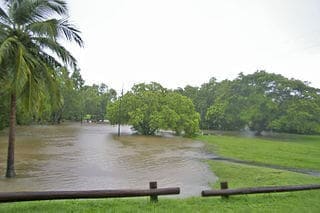All the hoopla about increasingly destructive tropical storms may be distracting people from the fact that sea-level rise will threaten coastal communities, come what may.
A review of 100 or so research studies found accelerated sea-level rise certainly will increase the flooding and property damage triggered by tropical cyclones — commonly known as hurricanes in the Atlantic and Northern Pacific — but predicting where, how often, and how powerful these storms will be when they make landfall is full of uncertainty.
“The potential for sea-level rise to dramatically change the landscape is an understudied aspect of coastal flooding,” said Jennifer Irish, an associate professor of civil and environmental engineering with the Virginia Tech College of Engineering. “For example, shoreline erosion, barrier-island degradation, and new tidal inlet formation — these sedimentary changes could lead to catastrophic changes in hurricane flood risk in some areas.”
The research team, led by Jonathan D. Woodruff, an assistant professor of sedimentology and coastal processes at the University of Massachusetts Amherst, with Irish and Suzana Camargo, a Lamont research professor at the Lamont-Doherty Earth Observatory of Columbia University, said regardless of changes in storm activity, rising sea levels will become the dominant driver of flooding and coastal damage.
The scientists cited information from the International Disaster Database of the Center for Research on the Epidemiology of Disasters that indicates since 1970, more than 60 percent of all economic losses — about $400 billion — occurred in the North Atlantic, even though it is one of the least active basins for hurricanes.
The researchers stressed the importance of a holistic approach to manage coastal systems, especially in the context of almost certain flooding from tropical cyclones because of rising sea levels.
“Sea-level rise, severe storms, changing climate, erosion, and policy issues are just some of the factors to assess in order to understand future risk,” Irish said. “We reviewed just three of the physical factors — tropical cyclone climatology, sea-level rise, and shoreline change. If we look at them separately, we don’t see how they are interconnected. But if we pull back to look at the whole picture, we stand a better chance of protecting our homes, roadways, energy and water networks, and the most critical and expensive infrastructure along the coastlines.”
The review suggested that it is practical to focus on approaches that integrate vertical and landward retreat — meaning planners should consider elevated structures and building further inland — with other engineering and management measures, including sediment management.
“It is widely accepted that sea level will rise. We just don’t know how much,” Irish said. “We need to consider the full range of sea-level estimates and plan our engineering strategies from that, designing for moderate protection now in a way that these designs can be modified in the future if necessary. The Dutch have been dealing with this problem for centuries, so it can be done.”
Global sea level is expected to rise about one meter by 2100. According to a simulation study the researchers reviewed, floods currently to be considered 100-year events in New York City could become three- to 20-year events.


